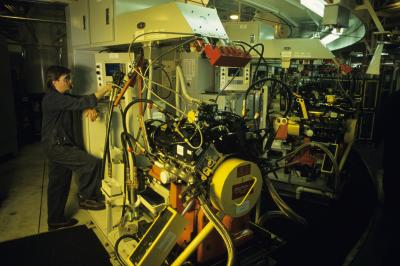
Setting an engine’s idle speed too high consumes fuel needlessly and generates unwanted emissions; allowing it to idle too slowly risks stalling if the air conditioning or some other unexpected load cuts in. Relying on trial and error to get it right is time-consuming and likely to give inaccurate results. Spark-based measurements are not possible for diesel engines, but using a hand-held tachometer to measure engine speed in rpm is accurate and relatively straightforward.
Position the vehicle so you have clear access to the nose, or front, of the crankshaft. If this is not possible, skip the remainder of this section. Select “Park” or “Neutral” and engage the vehicle’s parking brake. Clean the crankshaft nose by using a degreasing agent, taking care not to get degreaser on any adjacent pulleys or drive belts.
Fit an appropriate rpm adapter onto a contact tachometer in accordance with the manufacturer’s instructions. If a crankshaft pulley is fitted, select a funnel-shaped adapter that engages with the head of the retaining bolt. Otherwise, select a cone-shaped adapter that engages with the threaded hole on the end of the crankshaft.
Start the engine. Switch on the tachometer and set it to measure rpm in accordance with the manufacturer’s instructions. Press the adapter firmly against the end of the crankshaft, keeping the shaft of the adapter in line with the crankshaft and central on the nose. Ensure that you stay clear of all other moving parts. Once the display stabilizes, note the shaft speed in rpm.
Remove the tachometer and record the result. Turn off the engine. Repeat the procedure if necessary after you have made any adjustments.
Position the vehicle so you have clear sight of the crankshaft nose or crankshaft pulley. Select “Park” or “Neutral” and engage the vehicle’s parking brake. Clean the crankshaft nose by using a degreasing agent, taking care not to get degreaser on any adjacent pulleys or drive belts. If you cannot see the nose clearly, clean a small area on the visible surface of the pulley.
Cut a small piece of reflective tape that is suitable for use with a laser tachometer. Usually, this tape will be supplied with the tachometer. Consult the manufacturer’s instructions to confirm the size of the piece of tape. Apply the tape to the side of the shaft or to the front of the pulley as directed in the instructions.
Start the engine. Switch on the tachometer and set it to measure rpm in accordance with the manufacturer’s instructions. Direct the laser beam onto the reflective tape, hold the tachometer steady and wait until the display indicates it is ready to take a measurement. Ensure that you stay clear of all moving parts. When the display stabilizes, note the shaft speed in rpm.
Remove the tachometer and record the result. Turn off the engine and remove the reflective tape. Repeat the procedure if necessary after you have made any adjustments.